Gas Traction Engines
The term "gas traction engine" is applied to such as are propelled by an internal-combustion engine. The fuels most commonly used are gasoline, kerosene and the heavier oils.
The use of gas traction engines has been increasing much more rapidly than that of steam traction engines.
The reasons for this are as follows:
1. The gas traction engine is made in many special designs suitable for various uses.
2. The steam traction engine is practical only in large powers, while gas traction engines are built in sizes capable of pulling as few as two plows and as many as fourteen plows. This also means that gas traction engines sell at sufficiently low cost to enable the fairly small farmer to use this form of mechanical power. The prices of gas traction engines vary from $500 to $4,500.
3. The operator of the steam traction engine must carry a tank wagon with water and a bulky fuel supply. This necessarily limits the amount of plowing by this form of engine. With the gas traction engine the fuel and water supply occupy little space.
4. Considerable time must be consumed in getting up steam for operating a steam traction engine.
The Gas Traction-engine Motor
The majority of gas traction engines employ internal-combustion motors which operate on the four-stroke Otto gas-engine cycle. The motors are either vertical or horizontal and of the long-stroke type and operate at moderate speeds as compared with automobiles.
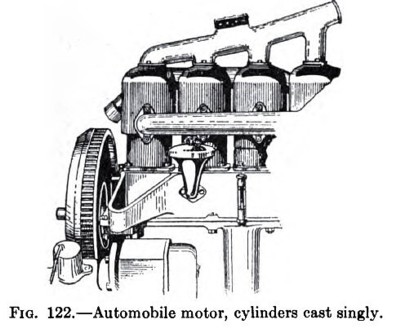 Automobile Motor-Cylinders Cast Singly |
The vertical motor resembles the automobile motor, but is usually heavier. The cylinders of the vertical motor are cast singly (Fig. 122); some makers cast cylinders in pairs. The four cylinder en-bloc type, common in automobile practice, is used to a limited extent for traction engines.
The horizontal motor is more difficult to lubricate and is bound to wear more rapidly than the vertical types.
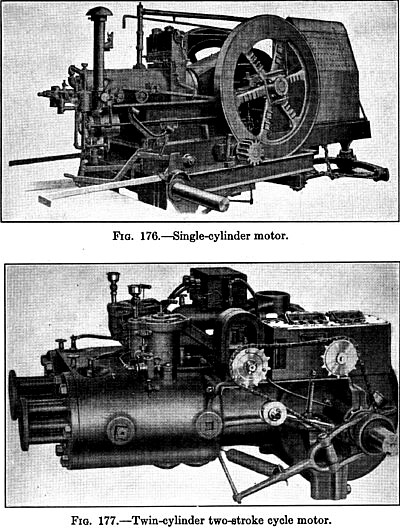 Single & Twin Cylinder Motors |
| 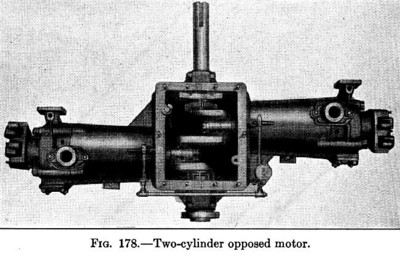 Two Cylinder Opposed Motor |
|
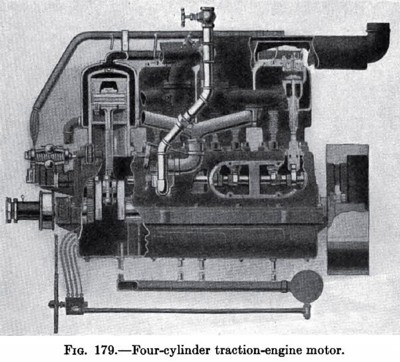 Four Cylinder Traction Engine Motor |
|
The types of motors used are single-cylinder (Fig. 176), twin cylinder (Fig. 177), two-cylinder opposed (Fig. 178), and four cylinder (Fig. 179).
The single-cylinder motor (Fig. 176) is usually of the long stroke heavy-duty horizontal type and has a heavy flywheel.
The two-cylinder traction engine is built as a twin-cylinder motor with cylinders mounted side by side, at one side of the crankshaft (Fig. 177), or as a two-cylinder opposed motor (Fig. 178) with two cylinders set horizontally on the opposite sides of the crankshaft. The two-cylinder opposed motor is better balanced and can be operated with lighter flywheels. The twin cylinder type of motor (Fig. 177) occupies less space and has better carburetion.
Multiple-cylinder motors are more commonly used, as they are lighter than the single-cylinder motor for the same power developed. Increasing the number of cylinders produces also a motor which has a more uniform turning effort at the crankshaft, the power impulses taking place more frequently.
The four-cylinder vertical motor (Fig. 179) is the most common type for large traction engines. The cylinders of the four-cylinder motor are usually placed so that the crankshaft is parallel to the tractor frame. In some designs the motor is set crosswise of the frame. In the crosswise arrangement the motor drive is direct, in the other method, the drive to the transmission is through bevel gears. While the direct drive eliminates the use of a bevel gear, the other design can be built with longer bearings without widening the frame. The length of the bearing is an important consideration in large traction engines.
The motor crankshaft has two, three, or five main bearings and one camshaft usually operates all the valves. The valve camshaft is driven from the motor crankshaft by a two-to-one gear, as is the case in stationary and automobile engines.
Traction-engine cylinders are made of cast iron and are provided with jackets for liquid-cooling. Air-cooled motors are not practical for traction engines.
Water is usually used as the cooling medium. Heavy oils and the various anti-freezing compounds, such as glycerine, alcohol and water, or alcohol and water, are also used to some extent.
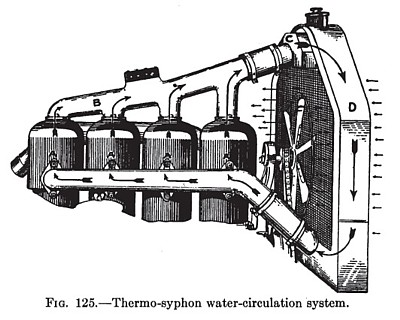 Thermo-Syphon Water-Circulation System |
A forced system of water circulation is usually employed with a rotary, a centrifugal, or a plunger pump. In the rotary pump the water is circulated by revolving gears and in the centrifugal pump by an impeller or paddle wheel. The rotary or centrifugal pumps are more generally used, as they are more simple. The thermo-syphon system of water circulation (Fig. 125) is used in some makes of traction engines.
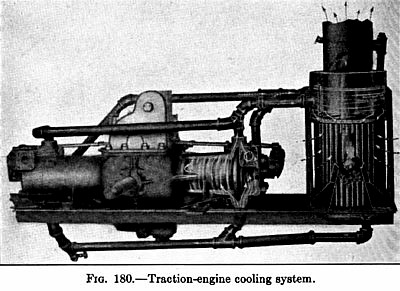 Traction Engine Cooling System |
| 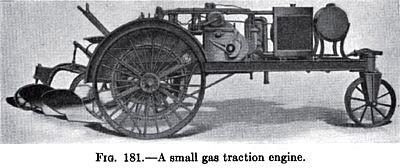 Small Gas Traction Engine |
|
Some form of radiator (Figs. 180, 181) is employed which acts as a water tank and cooler. In most traction engines the radiators are similar to those of automobiles but heavier; a cooling fan is used to circulate the air through the radiator. The exhaust gases are also utilized in some designs to aid in the circulation of the air.
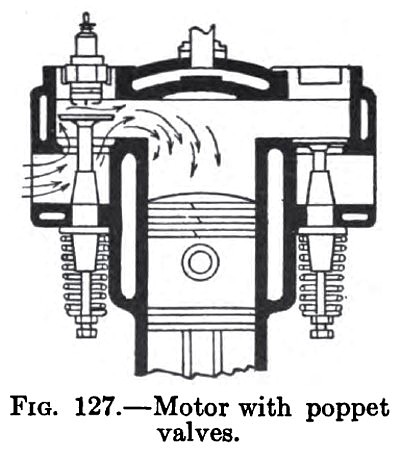 Motor with Poppet Valves |
The poppet type of valve (Fig. 127) is always employed. Valves are constructed of a nickel-steel or cast-iron head, and a carbon-steel stem, stem and head being welded together.
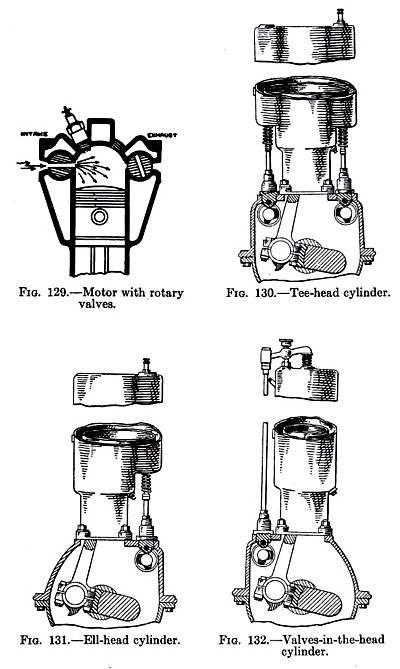 Automobile Type Valves |
The valves are arranged, as in automobiles (Figs. 130, 131, 132), in three distinct ways: namely, the tee-head, the ell-head and the valve-in-the-head construction. With the tee-head or the ell-head construction the valve seats are in a pocket cast on the side of the cylinder proper, which forms a very inefficient combustion space. The valve-in-the-head motor has a very compact combustion chamber.
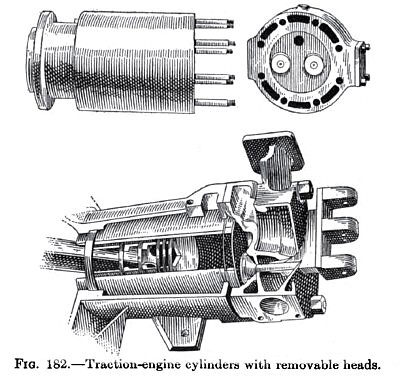 Traction Engine Cylinders with Removable Heads |
| 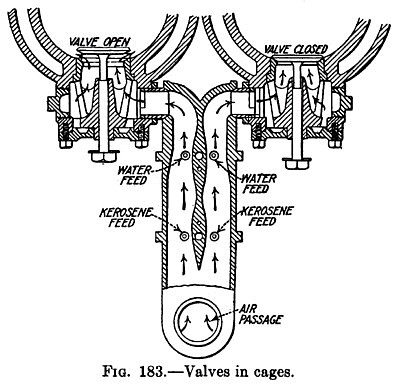 Valves in Cages |
|
In the valve-in-the-head type of motor, the cylinder head carrying the valves is a separate casting (Fig. 182) or has the valves mounted in removable cages (Fig. 183).
Many makes of traction-engine cylinders are built with removable heads (Fig. 182). When the cylinder head is a separate casting, it can be removed easily for the purpose of cleaning, and the valves, with this form of construction, can be more thoroughly water-jacketed than when mounted in cages.
When the valves are placed in cages (Fig. 183), the cage contains a seat for the valve and a guide for the valve stem.
The exhaust valve seat is usually water-jacketed and in some designs the inlet valve seat is also water-jacketed in order to keep down the temperature of the incoming mixture.
Traction engines are generally constructed with mechanically operated inlet and exhaust valves.
Some gas traction engines are provided with an auxiliary exhaust port. With this construction the exhaust gases pass directly into the exhaust pipe, removing the hottest gases from the exhaust valve and decreasing the pressure at the time the exhaust valve opens. This feature is particularly advantageous when the engine is operated continuously at heavy loads.
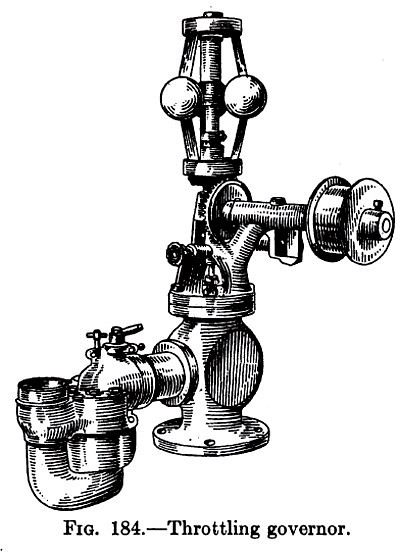 Throttling Governor |
Traction engines are governed by the hit-and-miss or by the throttling type of governor. The hit-and-miss governor is not adapted for work where close regulation is essential. The majority of modern gas traction engines are equipped with throttling governors. The throttling governor is of the centrifugal type and controls the carburetor throttle (Fig. 184). In some cases the controlling mechanism is arranged so that the governor may be cut out, and the carburetor throttle is controlled by a hand lever.
The speed of various makes of traction-engine motors varies from 365 to 1,500 r.p.m. The majority of motors operate at speeds of 500 to 750 r.p.m.
The belt horsepower of various makes of motors varies from 10 to 120 h.p.
Carburetors for Traction Engines
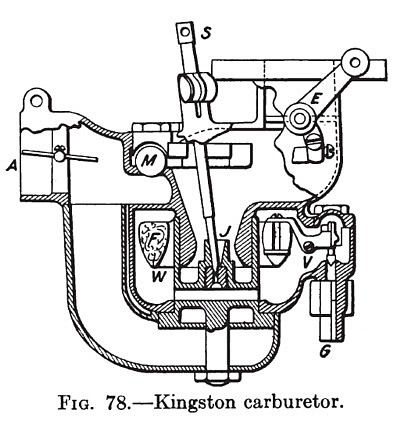 Kingston Carburetor |
Float-feed carburetors of the single-jet automobile type are used. The simpler designs, such as the Kingston (Fig. 78), are generally employed.
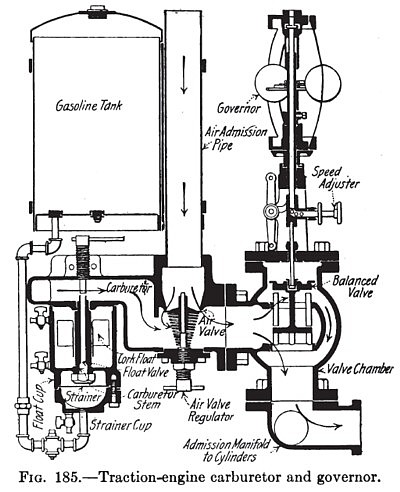 Traction Engine Carburetor & Governor |
The arrangement of carburetor and throttling governor for one form of traction engine is illustrated in Fig. 185. The carburetor is of the concentric-float type. The gasoline passes through a strainer before entering the float chamber. The fuel mixture on the way to the engine cylinder must pass through a balanced throttle valve, which is under the control of the governor.
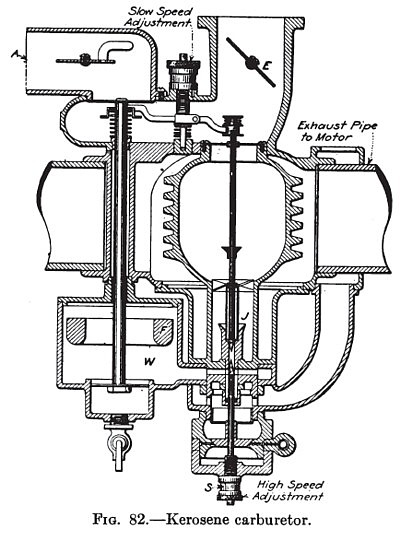 Kerosene Carburetor |
To burn kerosene, some makes employ the ordinary float-feed carburetor, which has a jacketed float chamber through which hot water passes. The kerosene carburetor illustrated in Fig. 82 is used by some manufacturers.
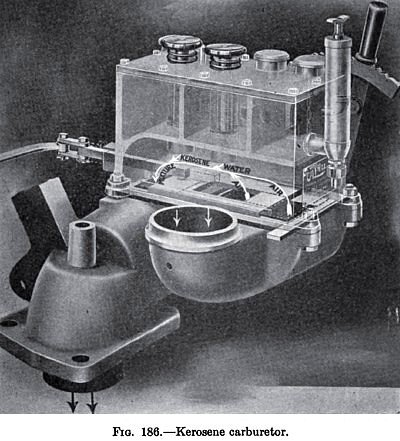 Kerosene Carburetor |
Another form of kerosene carburetor, called the Secor-Higgins, is illustrated in Fig. 186. The three compartments from right to left are for gasoline, water and kerosene. The lower section is the mixing chamber. Gasoline is forced into the mixing chamber by means of a hand pump. Plunger pumps force water and kerosene into the compartments. The air enters through air intake ports. The amount of air entering the mixing chamber is controlled by the governor. The throttle opening which admits the mixture to the cylinder is also under the control of the governor.
With kerosene fuel, water is generally mixed with the air and fuel to prevent preignition. Very little water should be used at light loads, and the quantity of water injected at higher loads should be sufficient only to produce proper operating conditions. With heavier liquid fuels, the capacity of an engine of the same bore, stroke and speed is increased by water injection. Water injection also reduces the amount of carbon deposit, but produces a slower burning mixture with the consequent poorer fuel economy.
The majority of traction engines are equipped to burn kerosene as well as gasoline.
Ignition for Gas Traction Engines
Nearly all traction engines operate with the jump-spark system of ignition. The jump-spark system is simpler mechanically, having fewer parts than the make-and-break system. The ignition system differs from that used in automobiles in that magnetos are commonly employed. In some cases the dual system is employed, in which the motors are started with current supplied from a dry or storage battery, but operate with magnetos. In other makes, the motor is started on the magneto. The present tendency seems to be to eliminate the battery and to use the magneto for starting.
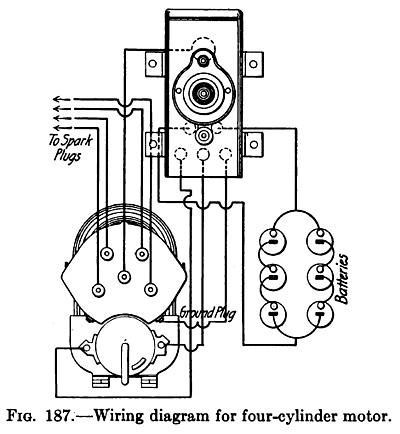 Wiring Diagram for Four Cylinder Motor |
A wiring diagram for a four-cylinder traction engine is illustrated in Fig. 187.
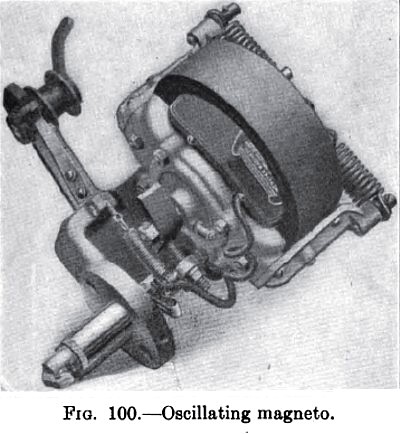 Oscillating Magneto |
The make-and-break system of ignition is used to a limited extent for small traction engines in connection with a slow-speed single-cylinder motor. With the make-and-break system an oscillating magneto (Fig. 100) is often employed.
Transmission Systems and Differentials
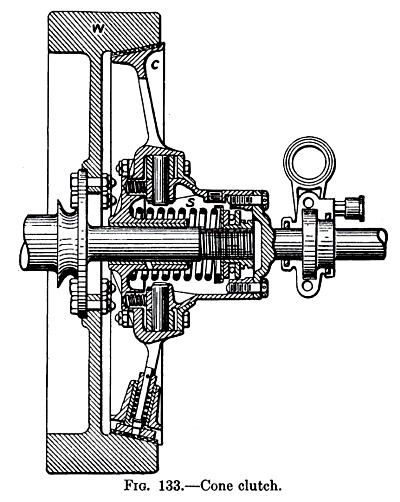 Cone Clutch |
| 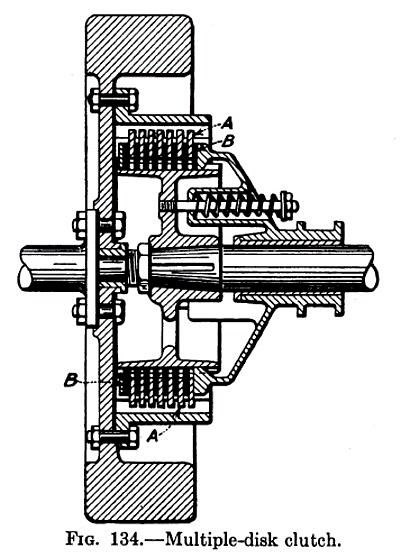 Multiple Disk Clutch |
|
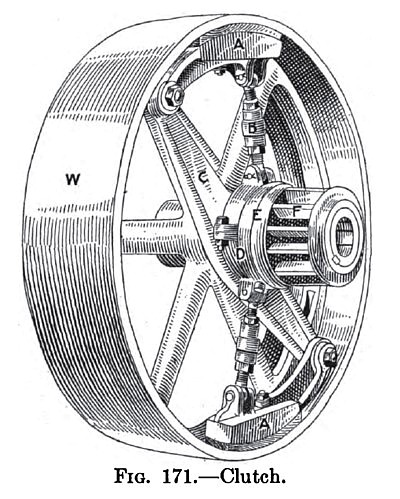 Traction Engine Clutch |
| 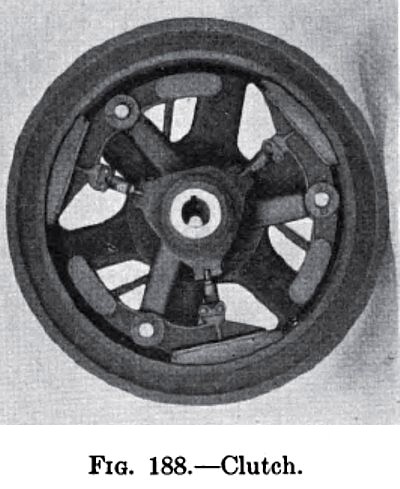 Traction Engine Clutch |
|
The clutch of the gas traction engine has the same function as that of the automobile and connects or disconnects the motor from the propelling gear. The types of clutches used for gas traction engines are similar in principle to those illustrated in Figs. 133, 134 and 171. The expanding-cone, expanding-shoe, multiple-disc, floating-plate and clamp-plate types are employed. Usually one part of the clutch is part of the flywheel. A traction-engine clutch is illustrated in Fig. 188.
Some traction engines are constructed with a single reversing mechanism and without speed-change gears, while other traction engines have the reversing mechanism incorporated with the speed-change gears; some manufacturers employ a reversing mechanism which is separate from the speed-changing mechanism. The highest speed in the case of traction engines is usually obtained through gearing instead of by the direct motor drive. The reason for this is that the traction engine is used most of the time for plowing or for other heavy work, which requires a slow speed; by operating the direct drive at the slower speeds the heavy work can be accomplished with few gears, thus increasing the efficiency of the drive.
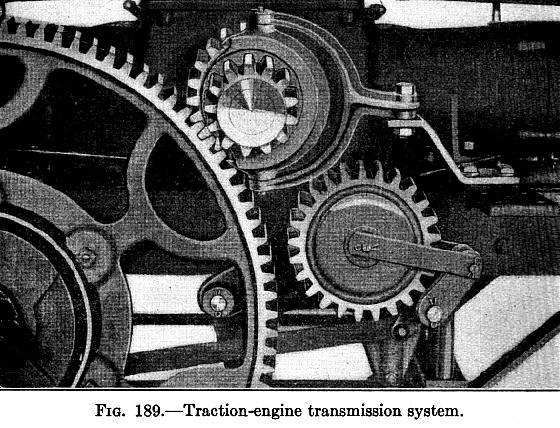 Traction Engine Transmission System |
| 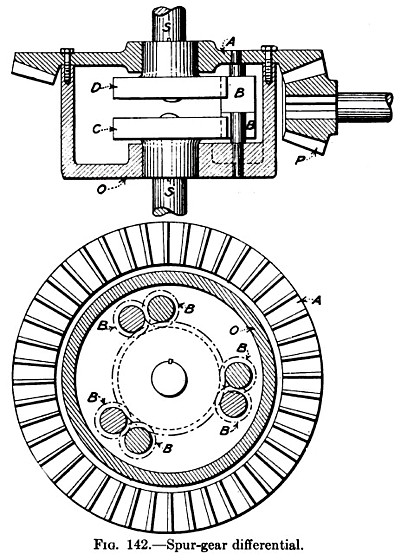 Spur-Gear Differential |
|
One simple form of gas traction-engine gearing is illustrated in Fig. 189. The differential gear used in connection with the engine of Fig. 189 is of the spur-gear type similar in principle to that illustrated in Fig. 142.
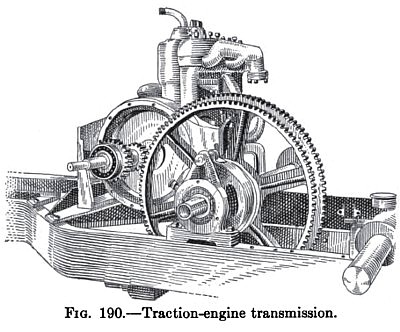 Traction Engine Transmission |
Another simple traction-engine transmission system is illustrated in Fig. 190.
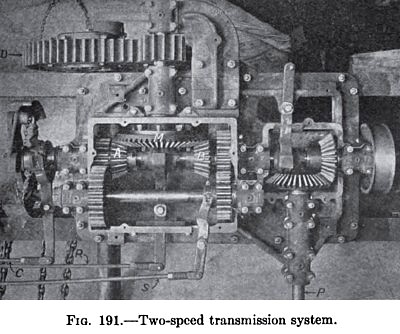 Two Speed Transmission System |
A two-speed transmission system is shown in Fig. 191. The reversing mechanism consists of two bevel pinions (
A, B) which are driven from the motor shaft. The bevel gears
A and
B drive the differential driving gear
D through the large bevel gear
M. In the neutral position these bevel gears A and B revolve freely. The lever R is used for connecting either bevel gear
A or
B with the driving shaft. The lever
S controls the speed freely. The lever
R is used for connecting either bevel gear
A or
B with the driving shaft. The lever
S controls the speed changing gears and the lever
C is for the clutch. The shaft
P is for the belt pulley.
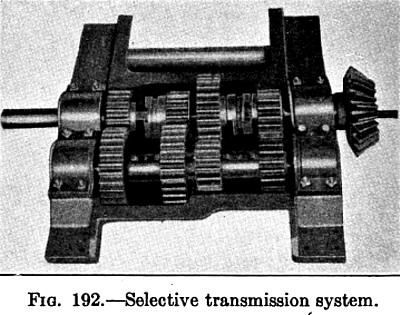 Selective Transmission System |
In some traction engines the speed-changing mechanism is similar to that used in automobiles. The type generally used is the selective transmission system (Fig. 192).
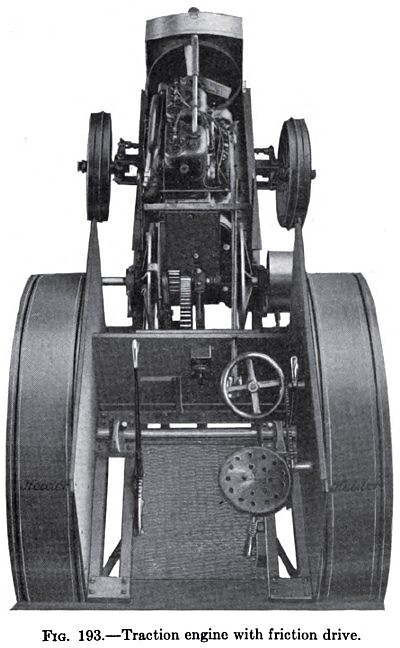 Traction Engine with Friction Drive |
A friction drive (Fig. 193) is employed in some makes, this drive differing from automobile friction drive in that the fibrous-covered fiction wheel is mounted on the engine crank-shaft; in automobiles the disc is the driving member.
In some designs, clutches are used for reversing. A single lever operates two clutches, one of which is used for reversing.
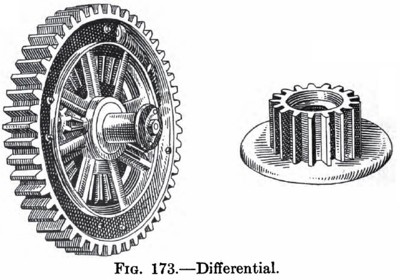 Differential |
| 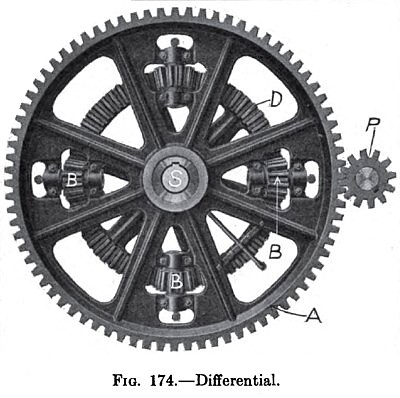 Differential |
|
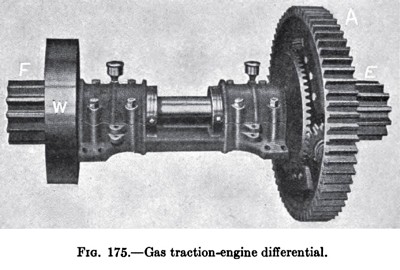 Gas Traction Engine Differential |
|  Spur-Gear Differential |
|
Differentials for gas traction engines were illustrated and described in connection with Figs. 173, 174, and 175. Spur-gear differentials similar to that of 142 are also employed in some gas traction engines. Some of the light traction engines dispense entirely with the differential and use only one traction wheel.
Type of Traction
The majority of traction engines use the two rear wheels as the traction wheels or drive wheels, while the two front wheels are for steering. Some makes use a traction drum, several are constructed so that the front wheels are the driving wheels, and in other makes, all four wheels drive. In the case of three-wheeled traction engines, one large drum, two front wheels, or two rear wheels are used for driving.
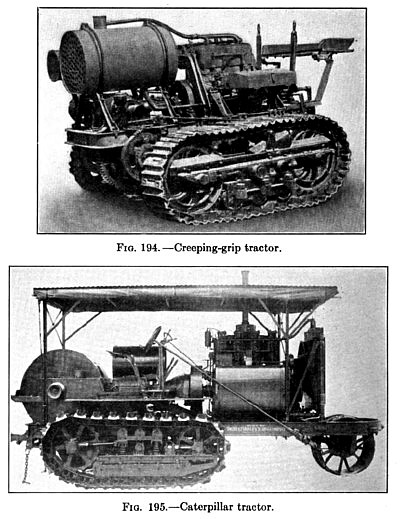 Creeping-Grip & Caterpillar Tractors |
| 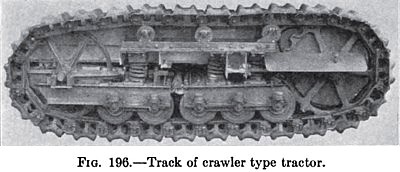 Track of Crawler Type Tractor |
|
Traction engines are also built on the "creeping-grip" or "caterpillar" principle (Figs. 194, 195, 196), which employ a crawler instead of a wheel or drum. The object of this construction is to have the traction wheels travel over a continuous, metallic track approximating as nearly as possible that over which the locomotive travels. The creepers or tractor shoes run inside a continuous belt. Power from the motor is transmitted from a jack-shaft to the creeper drive wheels by a chain and sprocket drive on either side. The advantages of this construction are greater gripping surface for the same weight and better distribution of weight.
Uses of Traction Engines
Desire on the part of farmers to raise large crops and to put under cultivation great areas of land created a demand for mechanical power. With mechanical power the number of horsepower under the control of one man becomes unlimited, if the man controlling the mechanical power is willing to learn the simple fundamental processes which govern the conversion of fuel into mechanical energy as well as the simple laws of mechanics which enable one to keep machines and mechanisms in adjustment and in perfect working order. A traction engine is capable of doing the following field work: Clearing the land: tearing out hedges, pulling up trees, stumps and stones.
Preparing the seed bed and seeding with the operation of plowing, listing, disking, harrowing, drilling, seeding. Harvesting operations such as mowing, hay loading, hay hoisting, and drawing binders and diggers.
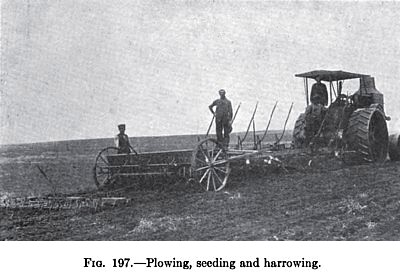 Plowing, Seeding & Harrowing |
| 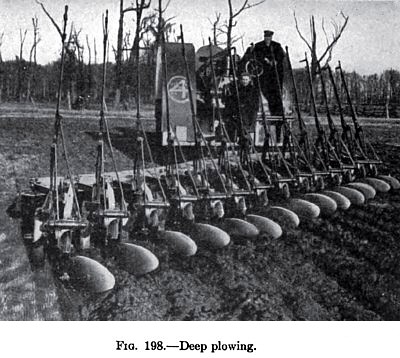 Deep Plowing |
|
With a traction engine the processes of plowing, seeding, and harrowing can be carried on in one operation (Fig. 197). Deeper and more uniform plowing (Fig. 198) can be carried on.
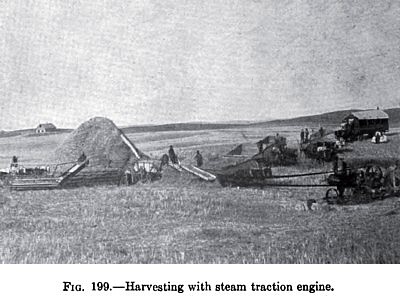 Harvesting with Steam Traction Engine |
| 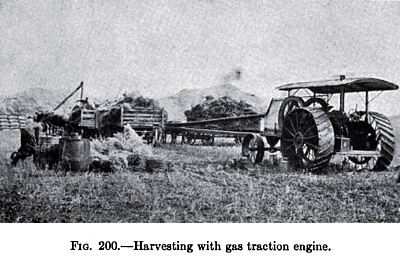 Harvesting with Gas Traction Engine |
|
Harvesting operations with steam and gas traction engines are illustrated in Figs. 199 and 200.
Some designs of traction engines are built low and are suitable for orchard cultivation.
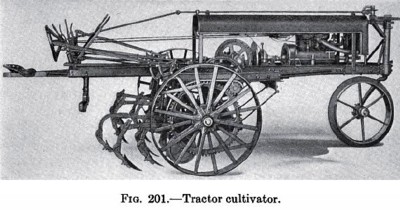 Tractor Cultivator |
Power cultivators are being placed on the market which are suitable for cultivating corn and other rowed crops. One form of tractor cultivator is illustrated in Fig. 201. The motor of this machine is placed on the frame near the front and is a four cylinder vertical internal-combustion motor with the cylinders cast en-bloc similar to automobiles. One of the special features of this traction engine is that the two drive wheels are operated separately by means of friction-drive transmission. The mechanism is so arranged that one wheel can be held stationary while the other travels forward or backward. To facilitate turning around at the end of a row of corn, in order to go up in the next row, the operator throws out the gear connection in the steering apparatus and the front wheel acts as a caster. Then, by operating the rear wheels, the machine can be made to turn completely around. The cultivator gangs are operated by the driver's feet.
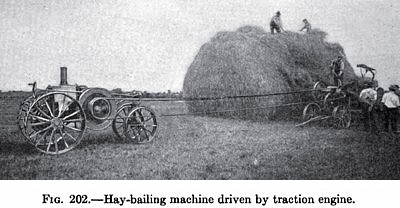 Hay Bailing Machine Driven by Traction Engine |
The traction engine is suitable for heavy-belt work, such as hay baling (Fig. 202), corn shelling, pumping water for irrigation and for other purposes, grinding feed, ensilage cutting, sawing wood, threshing, husking, hulling, shredding, filling silos, crushing rock, and elevating corn and grain.
Traction engines can be used for hauling grain and other farm products to the shipping point or to the market; for hauling fertilizer and other material to the farm; also for moving houses, barns and other structures.
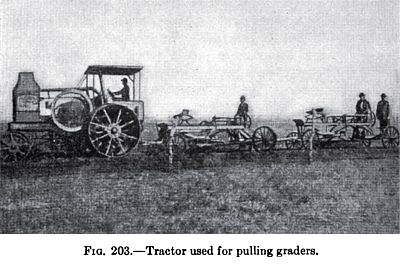 Tractor Used for Pulling Graders |
In connection with road work, traction engines are used for pulling graders (Fig. 203), scrapers, road plows, drags, and other road implements, as well as road materials.
Traction engines can be used for digging irrigation ditches and for filling drainage ditches.
Development of the Gas Traction Engine
The development of the gas traction engine has been exactly the reverse of the automobile. The earlier automobiles were small and light in weight; the early gas traction engines were very heavy, developing 60 to 100 hp. on the belt. At the present time traction engines developing 5 to 15 hp. on the draw-bar (10 to 30 b. hp.), and capable of pulling three or four 14-in. plows, are used in great numbers in the corn belt. Large steam or gas traction engines developing 40 to 60 draw-bar horsepower and capable of handling 10 to 14 plows, are used in the Northwest and in other parts where large areas must be cultivated and farm labor is scarce. The tendency seems to be for the large farmers to invest in several machines, each designed for a special purpose, than to buy one all-purpose machine capable of performing all the work of the farm.
Attachments are available for converting an automobile into a light traction engine, capable of pulling one or two plows. The rear wheels of the automobile are replaced with pinions, which mesh with gears on the traction wheels. The traction wheels revolve on a special axle at a speed, which is one-eighth to one tenth, that of the automobile rear axle.
The traction engine probably will not replace the horse for all purposes very soon, but will replace many horses, on large farms, and especially in connection with the heavy farm work. The traction engine is a concentrated form of power plant, which can work day and night, is not affected by heat, and can be used to advantage a large portion of the year.
Economy of Gas Traction Engines
The cost of operating a gas tractor depends upon many varying factors, such as the kind of fuel used, the cost of fuel, the cost of attendance, the character of the soil, and the type of machine.
Experiments carried on during 1915-1916 in the engineering laboratories of the Kansas State Agricultural College indicate that the fuel consumption in pounds per brake horsepower per hour is very nearly the same for gasoline and for kerosene. The fuel consumption per brake horsepower per hour (average of tests on 12 different traction engines) was found as follows:
 Gas Fuel Consumption |
With kerosene at 10¢ per gallon and gasoline at 20¢ per gallon, the cost of gasoline fuel will be about twice that of kerosene for the same power developed. The advantages of kerosene fuel, due to the lower cost, are offset to a greater or less degree, depending upon the operator, by the added trouble in handling the traction engine. The life of the motor probably will be less with kerosene fuel. To this should be added the lower reliability insurance with the heavier fuels. In some work done by traction engines reliability is the most important factor.
Rating of Traction Engines
Two ratings are usually given to traction engines. One is in brake or belt horsepower. This means the actual power developed at the shaft of the engine, which can be utilized for driving various machines by means of a belt drive.
The other rating is in tractive or draw-bar horsepower. To obtain the tractive horsepower the amount of power lost in transmission to the drive wheels and that required to propel the traction engine must be subtracted from the brake horsepower developed at the shaft of the engine.
The tractive horsepower depends on the kind of transmission gearing and on the character of the roads over which the traction engine must be propelled. It is equal to from one-half to two thirds of the brake horsepower. As an illustration, a traction engine equipped with a 40-hp. engine will be able to produce only 20 to 27 hp. at the draw-bar under ordinary conditions.
The belt horsepower of various makes varies from 10 to 120 hp. and the draw-bar horsepower from 5 to 60 hp.
The ratings are usually expressed as 8-16, 5-10, or 40-80. These ratings mean 8 draw-bar horsepower and 16 belt horsepower, 5 draw-bar horsepower and 10 belt horsepower, etc.
The relation between the rating and number of 14-in. plows a gas traction engine will pull is approximately as follows:
| Rating | | Number of plows |
| 5-10 | | 1 or 2 |
| 8-16 | | 2 or 3 |
| 10-20 | | 3 |
| 12-25 | | 3 or 4 |
| 20-40 | | 5 or 6 |
| 30-60 | | 8 or 10 |
Gas traction engines range in road speed from 1½ to 10 miles per hour. The average road speeds are 2 to 3 miles per hour. The furrow speeds in miles per hour vary from 1 to 3½. The average furrow speed is not greater than 2 miles per hour.
The drawbar pull in pounds, of a traction engine, traveling at a rate of about 2 miles per hour, is approximately 180 times the draw-bar horsepower.
Operation and Care of Traction Engines
The general directions given regarding the care of stationary steam and oil engines apply also to the motors of steam and gas traction engines.
The wearing surfaces must be well-lubricated or they will wear out, and lost motion in bearings must be avoided to prevent pounding and broken crankshafts. Many of the traction-engine troubles can be traced to inefficient lubrication or to the use of poor lubricating oil.
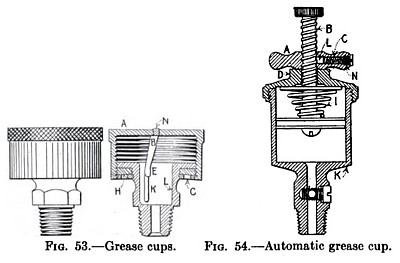 Grease Cups |
| 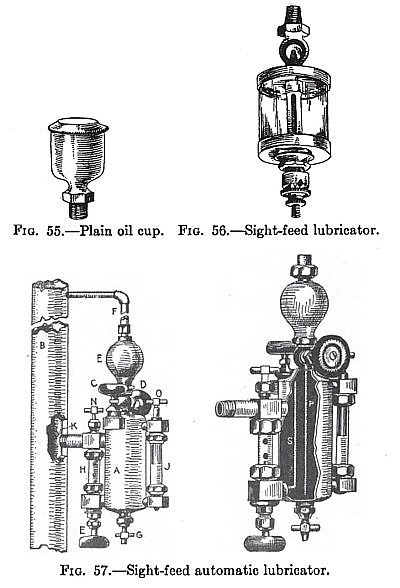 Sight Feed Lubricators |
|
Bearings may be oiled by means of grease cups (Figs. 53, 54), or by sight-feed lubricators (Fig. 56). Gears are lubricated with grease or with some other heavy lubricant. Transmission grease is generally used for the transmission. In some cases heavy steam-cylinder oil is employed for the same purpose. Cylinders for steam traction engines are lubricated with heavy steam cylinder oil by a mechanically driven oil pump or by an automatic sight-feed steam lubricator (Fig. 57). A medium gas-engine cylinder oil should be used for lubricating gas traction-engine. A combination of splash and forced-feed oiling system is often used for traction-engine lubrication.
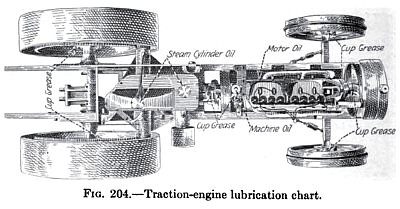 Traction Engine Lubrication Chart |
The instructions furnished by the manufacturer regarding the kind of oil to be used and the lubrication of the various parts should be carefully followed. A lubrication chart for one make of traction engine is illustrated in Fig. 204. The bearings of magnetos require frequent attention. A high-grade sewing machine oil should be used for this purpose.
All reputable manufacturers test their traction engines before shipment from the factory. The purchaser, upon receiving a traction engine, should carefully examine all parts. The railroad company and the manufacturers should be notified at once if any parts are damaged or missing.
Before attempting to start the engine, it should be gone over carefully, all nuts tightened, bearings properly set, lubricators filled, and clutch adjusted so that all shoes come into contact with the inside of the wheel at the same time. The operator should make certain that the engine has a sufficient supply of fuel and water and that the lubrication system is in good working order. The fuel for a gas traction engine should be strained. A chamois skin strainer is best for gasoline while a funnel with a fine screen will be satisfactory for kerosene fuel. A strainer will prevent dirt from getting into the carburetor and the supply pipes from clogging.
In the case of steam traction engines the boiler is filled about two-thirds full of water and the fires are started. Upon first using a boiler it is liable to foam, especially if the water is bad, but after washing the boiler, or changing the water several times, the oil and grease on the boiler plates are removed. Clear, soft water should be used. Care should be taken not to use water, which contains lime. The water gage cocks should be tried often and the water level should not be allowed to be below the second gage. Before the feed-water pump is started the operator should make certain that the feed line to the boiler is not closed. It is desirable to use the pump and to keep the injector as a reserve for emergencies. In simple single-cylinder traction engines the safety valve is set at about 130 lb., in compound engines at 160 lb. The fire should be kept thin. The operator should fire frequently and lightly. In operating a steam traction engine on the road care must be taken not to allow the engine to remain with its rear end elevated for any great length of time, as this may result in the overheating of the crown sheet. The water glass must be blown out two or three times each day and the safety valve should be kept in good working order. The reverse lever should be kept as close to the center notch of the quadrant as possible in order that the engine may operate at its best economy. When running, the throttle should be wide open and the steam supply to the engine should be varied entirely by the reverse lever. The fire flues of the boiler should be cleaned frequently, as the cleaner the flues the less fuel will be required to keep up steam.
In starting a gas traction engine, the operator should be certain that the change gears are in the neutral position and that the clutch is disengaged. In the case of a dual-ignition system the switch should be closed on the battery side. The spark lever is then retarded and the carburetor throttle is opened so as to admit a small supply of fuel. The shutoff valve at the gasoline tank is opened, the cylinders are primed through the priming cocks, and the motor is cranked. The quicker the crank is turned the easier the engine will start. After the motor starts, the spark lever is advanced. Some traction engines are started by means of small auxiliary gasoline engines.
To put the traction engine in motion the clutch is thrown in gradually after the lever controlling the change gears has been shifted to the position required. In stopping a traction engine, the carburetor throttle is closed, the switch is opened, the clutch is disengaged and the change-speed lever is placed in neutral. Failure to place the lever controlling the change gears in the neutral position will start the tractor if the clutch is disengaged. The operator never should try to reverse a traction engine without first bringing the machine to a stop. The operation of the traction engine is controlled by the carburetor throttle lever.
One accustomed to driving an automobile will find the traction-engine steering mechanism less sensitive. More turns of the steering wheel will be necessary on account of the slower speed of the traction-engine motor and the lower gear ratio of the steering gear.
In running a traction engine on the road, the operator should keep his eyes on the front wheels to prevent accidents. In case a traction engine is landed in a hole, it can be pulled out by placing chains, boards, or straw under the drive wheels. The same advice applies when the engine slips. Before crossing a bridge the operator should ascertain that it is safe. In case of doubt, planks should be placed to distribute the load.
A competent operator handles a traction engine slowly and deliberately, and never hesitates to stop, if something goes wrong with any part of the engine.
Overloading a traction engine is a serious mistake.
A traction engine should be kept at all times in adjustment and in perfect working condition. This cannot be accomplished unless the engine is housed properly. A traction engine represents a large investment, the depreciation of which can be greatly reduced if the housing question is carefully considered. A frame or a concrete structure should be provided which not only will house the traction engine but will leave sufficient space for a farm workshop where ordinary repairs can be made.
The tractor operator should do his repairing systematically. At the completion of a hard season's work the machine should be thoroughly overhauled. All old grease and oil should be removed from cylinders, bearings and transmission case. All parts should be cleaned with kerosene. Bearings should be examined, and adjusted by means of liners. In ordering repairs for engines, give description or sketch of the part as well as the number and letters found on the parts wanted. The number and size of the engine also should be stated.
The clutch should be examined frequently for worn parts.
It is well to have on hand an extra clutch lining, a set of piston rings, an extra connecting rod, several new spark plugs, cotter pins, belts, and nuts of various sizes and such other small repair parts as may be worn out or lost in the operation of the engine.
Valves for gas traction engines should seat properly and should be reground if indications show wear. To grind the valve into its seat the valve spring is removed and the valve is taken out. Flour emery dust and oil, or fine Carborundum valve-grinding paste and oil is placed on the valve seat. By using a brace holding a screw-driver bit in the slot on the top of the valve, the valve may be revolved back and forth on the seat with very little effort. It is best to place a light spring on the valve stem so that the valve is held up and off from its seat.
The time of opening and of closing of the valves of gas traction engines depends upon the speed of the engine. The valves of a high-speed engine should open sooner and remain open longer than those of a slow-speed motor. Ordinarily, the exhaust valve should open 30° to 50° before the beginning of the exhaust stroke and should remain open 4° to 10° after the completion of that stroke. The inlet valve should open 5° to 12° after the beginning of the suction stroke and should close 18° to 25° after the completion of the suction stroke.
The common sources of trouble with a traction engine are due to the incompetency of operators, who are responsible for poor or insufficient lubrication, dirty fuel, carbon deposits, poor fuel economy and high depreciation.
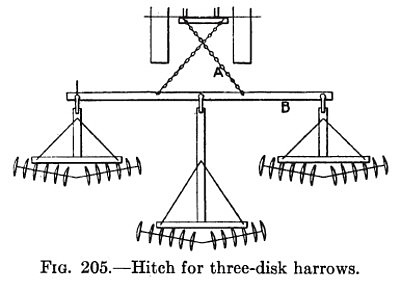 Hitch for Three-Disk Harrows |
When it is desired to draw a number of machines at the same time by means of a traction engine, care must be taken that the machines are properly hitched to the engine. The hitch required for plowing is very simple. A hitch for three-disc harrows is illustrated in Fig. 205. This consists essentially of a supplementary draw-bar
B which is connected to the main draw-bar by the chain
A.
In laying by the engine for the winter, it should be placed under cover and be protected from rain and snow. It is well to remove pistons from the cylinders of gas traction engines, clean all deposits and then oil pistons, cylinders and valves with a heavy oil. Magnetos and batteries should always be removed to a dry place. All parts should be carefully drained. In fact, it is well to remove all drain cocks so as to prevent any water from remaining in cylinders and tanks.
The success of a traction engine depends not only on the operator but also on the business ability of the owner. The farmer should so plan his work that the traction engine is used not only for plowing, but also for many other kinds of work. To secure the best results the traction engine should be kept busy most of the year.
Information Sources
- Farm Motors by Andrey A. Potter 1917 pages 180-208